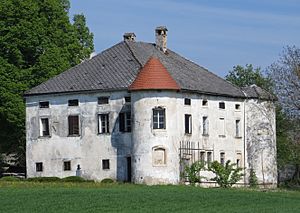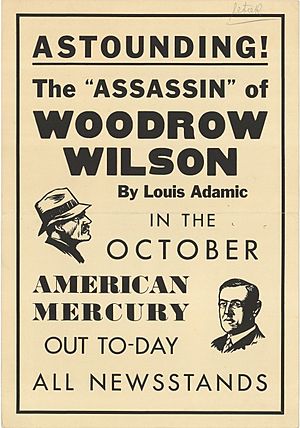Louis Adamic facts for kids
Quick facts for kids
Louis Adamic
|
|
|---|---|
 |
|
| Born |
Alojzij Adamič
March 23, 1898 Praproče pri Grosupljem, Austro-Hungarian Empire (present-day Slovenia)
|
| Died | September 4, 1951 (aged 53) Milford, New Jersey, United States
|
| Nationality | Yugoslav |
| Occupation | Author, translator |
| Awards | Anisfield-Wolf Book Award for From Many Lands |
Louis Adamic (Slovene: Alojzij Adamič) was an important writer and translator. He was born in Slovenia in 1898 and moved to America when he was 15 years old. He is famous for writing about how different cultures and people make the United States special. He believed in celebrating America's many ethnic groups.
Contents
Early Life and Move to America
Louis Adamic was born in 1898 in a place called Praproče Mansion in Slovenia. At that time, Slovenia was part of a big empire called Austria-Hungary. His birth name was Alojzij Adamič. His parents, Anton and Ana Adamič, were farmers.
Louis went to school in his city and later in Ljubljana. When he was in primary school, he joined a secret student group. This group was part of a movement that wanted to create a country for South Slavic people.
In November 1913, Louis was part of a student protest. He was briefly put in jail and then kicked out of school. He was not allowed to go to any government schools after that. Louis decided he wanted to go to America. He wrote, "No more school for me. I was going to America."
On December 31, 1913, when he was just 15, Louis Adamic moved to the United States. He eventually settled in San Pedro, California, a town with many Croatian immigrants. In 1918, he became an American citizen and changed his name to Louis Adamic.
His Career as a Writer
Louis Adamic first worked as a manual laborer. Later, he worked for a Yugoslavian newspaper in New York called Narodni Glas, which means "The Voice of the Nation." During World War I, he served as an American soldier on the Western Front. After the war, he became a full-time journalist and writer.
Writing About America and His Homeland
Many of Adamic's writings were based on his experiences working in America and his memories of Slovenia. He became well-known in America in 1934 with his book The Native's Return. This book was very popular and taught many Americans about the Balkans region.
In 1932, he received the Guggenheim Fellowship award, which helps people do research and write. During World War II, he supported the Yugoslav National liberation struggle. He also helped create the United Committee of South-Slavic Americans to support Marshal Tito, a leader in Yugoslavia. From 1949, he was a member of the Slovenian Academy of Sciences and Arts.
Editor and Award-Winning Author
From 1940, Louis Adamic was the editor of a magazine called Common Ground. This magazine focused on the idea of different cultures living together in America.
He wrote many books, including:
- Dynamite: The Story of Class Violence in America (1931)
- Laughing in the Jungle: The Autobiography of an Immigrant in America (1932)
- The Native's Return: An American Immigrant Visits Yugoslavia and Discovers His Old Country (1934)
- From Many Lands (1940)
- Nation of Nations (1945)
In 1941, he won the Anisfield-Wolf Book Award for his book From Many Lands. This award recognizes books that help people understand racism and human diversity.
His Death
In 1951, Louis Adamic was found dead in his home in Milford, New Jersey. His house was on fire, and a rifle was found in his hand. The police investigated his death.
Some people believed he was murdered. For example, John Roy Carlson, who was at Adamic's burial, thought he was killed by enemies who were worried about a book he was about to publish called The Eagle and the Root. Other friends of Adamic also said he had received threats because he supported Tito and Yugoslavia.
A typist who worked for Adamic, Ethel Sharp, said he told her that four unknown men visited his home in 1950. They asked about his book The Eagle and the Root in a threatening way. However, Adamic did not seem worried by this visit and did not report it to the police.
Years later, in 1957, the new owner of Adamic's house found a large amount of cash hidden in a wall. Police thought the money might have belonged to Adamic.
His Legacy
Louis Adamic's work had a lasting impact. The famous mystery writer Rex Stout was a friend of Adamic. Stout's popular detective character, Nero Wolfe, was made a native of Montenegro, part of Yugoslavia, because of Adamic's influence. Adamic's death also inspired Stout's 1954 novel The Black Mountain, where Nero Wolfe returns to his homeland to find the killers of an old friend.
Writings
Articles in Harper's Magazine:
- "Racketeers and Organized Labor" (1930)
- "Sabotage" (1930)
- "Tragic Towns of New England" (1931)
- "The Land of Promise" (1931)
- "The Collapse of Organized Labor" (1931)
- "Wedding in Carniola" (1932)
- "Home Again from America," (1932)
- "Death in Carniola" (1933)
- "Thirty Million New Americans" (1934)
- "Education on a Mountain" (1936)
- "Aliens and Alien-Baiters" (1936)
- "The Millvale Apparition" (1938)
- "Death in Front of the Church" (1943)
Books:
As a Translator:
- Yugoslav Proverbs (1923)
- Yerney's Justice by Ivan Cankar (1926)
- Struggle by anonymous Yugoslav informants (1934)
- Yugoslavia and Italy by Josip Broz Tito (1944)
- Liberation. Death to Fascism! Liberty to the People! Picture Story of the Yugoslav People's Epic Struggle against the Enemy—To Win Unity and a Decent Future, 1941–1945 (1945)
As an Author:
- Truth about Los Angeles (1927)
- Word of Satan in the Bible: Christians Rightly Regard Ecclesiastes Suspiciously (1928)
- Robinson Jeffers: A Portrait (1929)
- Dynamite: The Story of Class Violence in America (1931)
- Boj (1969)
- Laughing in the Jungle: The Autobiography of an Immigrant in America (1932)
- Smeh v džungli: Avtobiografija ameriškega priseljenca (Slovenian translation, 1933)
- Smijeh u džungli : autobiografija jednog američkog useljenika (1932)
- The Native's Return: an American Immigrant Visits Yugoslavia and Discovers His Old Country (1934)
- Vrnitev v rodni kraj (1962)
- Grandsons: A Story of American Lives (1935)
- Lucas, King of the Balucas (1935)
- Cradle of Life: The Story of One Man's Beginnings (1936)
- House in Antigua: A Restoration (1937)
- My America, 1928–1938 (1938)
- America and the Refugees (1939, 1940)
- From Many Lands (1940)
- Plymouth Rock and Ellis Island: Summary of a Lecture (1940)
- Two-Way Passage (1941)
- Inside Yugoslavia (1942)
- What's Your Name? (1942)
- Foreign-Born Americans and the War with George F. Addes (1943)
- My Native Land (1943)
- Nation of Nations (1945)
- Dinner at the White House (1946)
- The Eagle and the Roots (1952)
See also
 In Spanish: Louis Adamic para niños
In Spanish: Louis Adamic para niños




